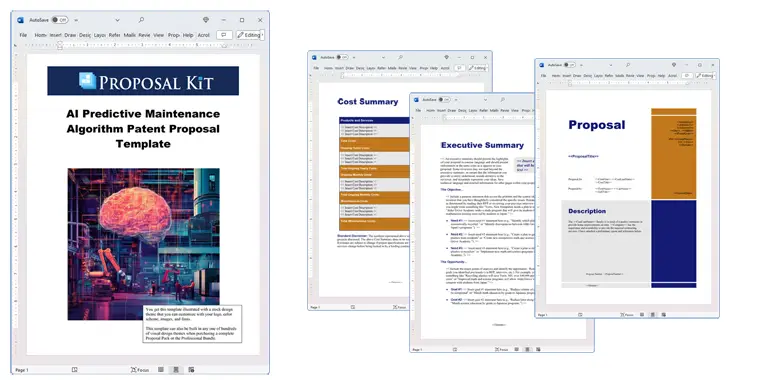How to write your AI Predictive Maintenance Algorithm Patent Proposal Template
We include this 23 page layout with every Proposal Pack. If you want this template to have a different visual design theme than the one illustrated here, purchase any Proposal Pack design and create this template using the purchased design theme. This template is included in every Proposal Pack. If you get a Proposal Pack or the Professional, you can also make any variation of this template with different chapters to suit your needs.
We typically include more chapters in the templates than most people will need to give everyone more variety in the chapters they may need. You can trim down a long template by removing pages you do not need or combining multiple chapter topics into one page.
 DOWNLOADABLE, ONE-TIME COST, NO SUBSCRIPTION FEES
DOWNLOADABLE, ONE-TIME COST, NO SUBSCRIPTION FEES If you need only this template pre-assembled on DVD media order from our Amazon shop.
If you need only this template pre-assembled on DVD media order from our Amazon shop.
You can also create countless variations of this document to suit your needs using the included library of 2200+ chapters if ordering a Proposal Pack or Professional.
 What Our Clients Say
What Our Clients SayI like the comprehensive set of templates, flexibility of use and useful samples that your product provides. This has been one of the most useful purchases I’ve made online."
Related Article
Related Video
Related Templates
- Patent Proposal
- Patenting New Technology Proposal
- Patent and Invention Licensing Proposal
- Selling a Company and Assets Counter Offer Proposal
- In-House Lab to Save Costs and Protect Trade Secrets Proposal
- Intellectual Property Rights Licensing Proposal
- AI Driven Health Diagnostics Proposal Template
- AI In Manufacturing For Predictive Maintenance Proposal Template
What's the best way to write your AI predictive maintenance algorithm patent proposal?
The clearest and most efficient way to write your AI-driven predictive maintenance algorithm patent proposal is by using the Proposal Kit template and software package. Proposal Kit offers a proven, step-by-step approach for building a winning document, combining an extensive library of premade templates with powerful software tools. You not only get access to customizable Word templates for every chapter you need, but you also benefit from a built-in line item quoting database for creating accurate cost summaries, budgets, quotes, and more. Proposal Kit's integrated AI Writer can generate a tailored first write of your proposal in minutes based on your unique details. When it's time to present your work, Proposal Kit's AI-powered PowerPoint conversion tool can turn your finished patent proposal into a professional slideshow.
If you're tasked with writing a patent proposal for a machine learning maintenance prediction solution - or any similar technical innovation - the Proposal Kit is designed to help you deliver a strong, organized, and convincing proposal that increases your chances of management approval and commercial opportunities.
What Types of Projects Are AI Predictive Maintenance Algorithm Patent Proposal Written For?
AI predictive maintenance solution patent proposals are written for a wide variety of projects that involve using machine learning to anticipate equipment failures and optimize maintenance. Here are examples of situations where these proposals are used:
- Patent application for an AI-powered railway track monitoring system
- Internal pitch to secure funding for predictive maintenance software in manufacturing
- Joint venture proposal for HVAC predictive maintenance using IoT sensors
- Licensing proposal for a machine-learning-based aircraft engine monitoring system
- Patent licensing offer for oil rig equipment failure prediction algorithms
- Proposal to commercialize maintenance optimization in hospital biomedical devices
- Bid to supply predictive maintenance solutions for city water treatment plants
- Presentation for patenting a smart vehicle fleet maintenance scheduling tool
- Proposal to integrate predictive maintenance in renewable energy farms
- Partnership pitch for AI predictive maintenance in data centers
- RFP for AI-based predictive analytics in municipal transit infrastructure
- Proposal to patent predictive maintenance for telecom network hardware
- Collaboration offers for predictive maintenance in chemical processing plants
- Grant proposal for developing predictive maintenance in agricultural machinery
- Proposal to patent AI algorithms for mining equipment failure prediction
- Business plan for commercializing predictive maintenance in warehouse automation
- Proposal to implement predictive maintenance in shipping container logistics
- Internal project proposal for predictive maintenance of HVAC in office buildings
- RFP response for predictive maintenance solutions in public school facilities
- Proposal to patent and license predictive maintenance for escalator and elevator systems
Chapters this template is built with
There is no one-size-fits-all, premade template for every situation. The Proposal Kit software is specifically designed to generate custom variations of templates that fit your unique project and audience, regardless of the scope or industry. Here is a starting point - a small selection from the thousands of chapter templates available within Proposal Kit - to help you customize your own patent proposal for an AI-driven maintenance prediction solution.
Cover Letter
In an AI predictive maintenance algorithm patent proposal, the cover letter is your professional handshake. Use this template to introduce yourself, your organization, and the core problem your AI solution addresses. Briefly highlight the intent to patent your machine learning algorithm and emphasize the commercial and operational benefits anticipated. Invite the recipient to review the detailed content and express your openness to further discussion or questions.
Title Page
The title page clearly states the proposal's name, such as "Patent Proposal.
AI-Powered Predictive Maintenance Algorithm for Industrial Equipment," along with the date and the submitting company or inventor's information. This template ensures there's no ambiguity about the proposal's focus, especially when dealing with patent offices or management boards that handle multiple innovations.
Table of Contents
A well-structured table of contents is important for a comprehensive, technical proposal. For an AI predictive maintenance algorithm patent proposal, this section lists all key chapters - such as Executive Summary, Technical Approach, and Cost Analysis - so reviewers can easily locate specific information about the AI model, patent claims, or business impact.
Introduction
The introduction provides a succinct overview of your AI-driven predictive maintenance project. Here, you'll outline the context for your invention - explaining the rising need for predictive solutions in your industry and how your machine learning approach sets the stage for operational transformation and protection of intellectual property through patenting.
Problem Statement
In this section, identify the specific equipment failure risks and inefficiencies in current maintenance practices. Explain how unplanned downtime causes losses and why traditional maintenance is insufficient. Present the gap your AI algorithm is designed to fill, making a direct case for why a patentable solution is necessary.
Executive Summary
The executive summary distills the proposal to its essentials. Here, summarize how your AI algorithm integrates with sensor data, predicts failures, and optimizes schedules. Emphasize the patentability, expected returns, and how commercialization, such as licensing, will benefit stakeholders.
Patents
In this chapter, detail the patent claims you're seeking, such as the novel topics of your machine learning methodology or proprietary data processing techniques. Explain your patent filing strategy, highlight any prior art searches, and clarify how your proposal meets patent office requirements for uniqueness.
Trademarks
If your AI maintenance solution has a distinct name or logo, use this chapter to describe any trademark applications or protections. Explain how trademarking the product name or service can enhance brand recognition in future licensing and commercialization efforts.
Proprietary Designs
Here, describe any unique hardware integrations, sensor arrays, or custom algorithmic frameworks that are part of your predictive maintenance system. Clarify what technical features differentiate your solution and how these designs contribute to its patentability.
Competitive Analysis
Conduct a detailed analysis of existing predictive maintenance technologies and patents. Compare performance metrics, implementation methods, and business models, showing how your AI algorithm offers superior accuracy, scalability, or cost-effectiveness.
Market and Audience
Use this section to define your target market, such as manufacturers, utilities, or transportation companies. Detail the size of the opportunity, user needs, and decision-makers who would adopt or license your AI predictive maintenance technology.
Licensing
Describe your plan for monetizing the patent through licensing. Outline different licensing models (exclusive, non-exclusive, region-based) and identify potential licensees, such as OEMs, technology integrators, or maintenance service providers.
Benefits
This chapter highlights the tangible and intangible advantages of your AI maintenance algorithm - such as minimizing unplanned downtime, reducing maintenance costs, improving equipment lifespan, and enhancing worker safety. Quantify these benefits where possible with statistics or pilot results.
Commercialization
Present your go-to-market strategy for the patented AI solution. Discuss sales channels, marketing approaches, pilot programs, partnership opportunities, and how your patent protection supports competitive advantage in the market.
Strategy
Lay out the high-level plan for deploying the AI predictive maintenance solution at scale. Cover stages from R&D to market rollout, including timelines, resource allocation, risk management, and how patent protection will be used during expansion.
Technical Approach
Use this section to detail the technical workings of your AI model - data sources (historical and real-time sensor data), machine learning algorithms, software architecture, and how the system integrates with existing maintenance workflows. Explain how this approach is both novel and effective.
Analysis
Present validated results from controlled studies, pilot implementations, or simulations. Provide data on prediction accuracy, false positive/negative rates, and improvements over current maintenance methods, demonstrating the real-world value of your AI innovation.
Cost Analysis
Leverage Proposal Kit's quoting database to break down costs for R&D, deployment, scaling, and ongoing support. Include estimates for hardware, software, cloud infrastructure, talent, and any other resources needed to bring the AI solution to market.
Income Projection
Forecast revenue streams from licensing, direct sales, or other commercialization paths. Use data-driven projections to demonstrate ROI for management or investors, supporting your argument for pursuing patent protection and investment.
Conclusions
Summarize the critical points of your proposal, the problem, your AI-driven solution, patentability, market potential, and recommended next steps. Restate the value proposition and invite decision-makers to approve the patent filing or move forward with commercialization.
Company Operations
Detail your organization's ability to execute, including team expertise in AI, software, and maintenance, as well as operational infrastructure. Show readiness to support the development, deployment, and long-term maintenance of the patented solution.
Appendices
Collect supporting documents here, such as technical schematics, data analysis charts, patent search results, or reference letters. This section offers reviewers a place to verify claims and review in-depth information as needed.
Back Page
Close your proposal with formal company information, contact details required, legal disclaimers, and any confidentiality notes. This gives reviewers a clear avenue for follow-up and reinforces your professionalism.
Use cases for this template
Turning Complex Hospital Device Maintenance into a Patent-Ready Proposal
The Challenge
At Biomedical Solutions, Charlotte led a technical team developing an advanced AI algorithm designed to predict failures in hospital biomedical devices before they occurred. The company saw enormous potential for both improving patient safety and commercializing the technology through licensing, but first, it needed a formal patent proposal that would satisfy executives, legal advisors, and potential partners. Charlotte faced the challenging task of compiling technical evidence, market research, cost justifications, and a solid strategy for licensing - all in a way that could be clearly understood by stakeholders from different backgrounds.
The Solution
Charlotte used Proposal Kit's comprehensive patent proposal template library, which included specialized sections for intellectual property, technical overviews, and commercialization strategies. By activating the integrated AI Writer, she was able to feed in her company's specific device data, real-world maintenance logs, and previous pilot results. The software produced written text for each section, including a concise executive summary and a tailored market analysis. The built-in quoting tool allowed her to break down implementation and licensing costs with a level of detail that impressed her finance team.
The Implementation
Charlotte spent her time refining the proposal and customizing template sections to reflect Biomedica's strengths and specific AI model capabilities. She used the appendices sections to include supporting analytics, industry testimonials, and technical diagrams. For the licensing section, Charlotte adapted the Proposal Kit's sample models to suit hospital procurement cycles. She found the process of editing and reviewing content remarkably efficient, freeing her to focus on fine-tuning the proposal's messaging for each audience.
The Outcome
The completed patent proposal not only earned unanimous approval from Biomedica's executive leadership but also sparked immediate interest from several leading hospital networks. Charlotte then used Proposal Kit's PowerPoint export feature to create a visually appealing, on-brand slideshow that made complex concepts accessible during her pitch presentation. This high-impact combination of a detailed written proposal and a professional slideshow helped pave the way for patent filing and future licensing opportunities and positioned Biomedica as a forward-thinking leader in healthcare technology.
Achieving Rapid Turnaround for Vehicle Fleet AI Maintenance Innovation
The Challenge
When FleetIQ Technologies developed an AI-powered scheduler for predictive vehicle fleet maintenance, Raj, their operations manager, found himself facing a tight deadline. Senior management needed a thoroughly documented patent proposal - complete with technical descriptions, business case, and commercialization roadmap - within a week. The pressure was high: the proposal needed to be clear, detailed, and convincing enough to justify investment and secure management's approval to move ahead.
The Solution
Raj turned to Proposal Kit's Wizard software and template system. He used the AI Writer to quickly generate first drafts for the technical background, problem statement, competitive analysis, and projected income chapters. By uploading FleetIQ's product specs and internal reports, as well as publicly available fleet management data, Raj enabled the software to create drafts specifically aligned with FleetIQ's technology and target market.
The Implementation
Raj carefully reviewed each AI-generated section, making edits to add proprietary information and insights from recent pilot deployments. He used Proposal Kit's quoting database to create precise cost and budget analyses, integrating real maintenance savings data to strengthen the business case. With the software's table of contents and appendices tools, Raj ensured the proposal was organized, professional, and easy to navigate. He finalized the document by tailoring the executive summary and conclusion to speak directly to FleetIQ's leadership priorities.
The Outcome
Raj delivered the proposal on schedule, earning praise from FleetIQ management for its thoroughness and focus. The document made it easy for decision-makers to see the patent's value and commercialization potential. To support the proposal, Raj generated a matching PowerPoint presentation using Proposal Kit's AI-powered export tool, which his team used during the final review meeting. The combined package secured internal approval for both patent filing and the next phase of product rollout, helping FleetIQ accelerate its path to market.
Launching a Transparent RFP Process for Municipal Water Plant Upgrades
The Challenge
As the program director at GreenCity Water Foundation, Naomi faced mounting concerns over aging water treatment infrastructure and the frequency of unforeseen equipment failures. The foundation wanted to implement an AI-driven predictive maintenance system to improve reliability and reduce costs, but first, Naomi needed to write a rigorous RFP (Request for Proposal) to solicit bids from qualified vendors. The RFP had to be comprehensive - covering technical requirements, regulatory issues, cost expectations, and evaluation criteria - while also being clear and accessible for both internal and external stakeholders.
The Solution
Naomi chose Proposal Kit's RFP and patent proposal templates to structure her document. She used the AI Writer to lay out regulatory compliance requirements specific to municipal water systems and prompted it with historical equipment data to create a data-driven problem statement. The customizable templates allowed Naomi to clearly define her evaluation process, ensuring all prospective vendors understood what was expected.
The Implementation
Naomi spent time customizing each chapter, from technical specifications to appendices showing recent failure statistics and maintenance logs. She used Proposal Kit's cost analysis tools to set realistic budget guidelines and required vendors to break down their pricing for transparency. The analysis and background sections pulled in research about the latest predictive maintenance technologies, setting a clear benchmark for the foundation's expectations. Naomi completed the RFP ahead of schedule, which allowed her team to circulate it for feedback and make final adjustments.
The Outcome
The well-organized and comprehensive RFP attracted a robust pool of qualified vendors, many of whom commented on the clarity and detail of the requirements. Naomi used Proposal Kit's PowerPoint export feature to generate a summary slideshow, which greatly aided the selection committee's vendor review meetings. Thanks to her efforts and the power of Proposal Kit, the foundation's project advanced smoothly to the next phase, giving GreenCity Water Foundation the confidence to invest in modernizing the city's water treatment plants with leading-edge AI solutions.
Conclusions and Recommendations
Writing a strong AI-driven predictive maintenance algorithm patent proposal is important for patent approval and commercialization. Proposal Kit offers a proven system to simplify the process - providing an extensive library of customizable templates, a robust quoting database, and an integrated AI Writer for fast, personalized content creation. Whether you're patenting a new invention, responding to an RFP, or pitching management, Proposal Kit ensures your proposal is well-organized, persuasive, and professionally presented - complete with a matching PowerPoint slideshow. No matter your specific project or situation, Proposal Kit helps you achieve your goals and move from idea to implementation with confidence.
Also Known As
This template may also be referred to in different ways or be used in more specialized situations, such as:
- Predictive Maintenance Machine Learning Patent Proposal
- AI Equipment Failure Prevention Proposal
- Smart Maintenance Algorithm Patent Application
- Machine Learning Maintenance Optimization Proposal
- AI-Based Equipment Failure Patent Pitch
- Predictive Analytics Maintenance Patent Proposal
- AI Sensor Data Maintenance Proposal
- Equipment Monitoring Algorithm Patent Proposal
- Automated Maintenance Scheduling Patent Proposal
- Predictive Maintenance Commercialization Proposal
Abstract
 Securing patent protection for artificial intelligence (AI) predictive maintenance algorithms involves navigating a complex landscape of patent law, intellectual property law, and practical application requirements. This process demands a comprehensive understanding of both the technical topics of computer-implemented inventions and the legal standards set by agencies such as the USPTO and the European Patent Office. Patent attorneys and legal teams must prepare robust patent claims that clearly distinguish the invention s unique aspects - such as proprietary software algorithms, neural network designs, anomaly detection methods, or novel uses of natural language processing - from existing patents and prior art. Ensuring patent eligibility requires demonstrating inventive steps, nonobviousness, and practical utility through well-drafted independent and dependent claims, as well as a detailed description of key features and embodiments.
Securing patent protection for artificial intelligence (AI) predictive maintenance algorithms involves navigating a complex landscape of patent law, intellectual property law, and practical application requirements. This process demands a comprehensive understanding of both the technical topics of computer-implemented inventions and the legal standards set by agencies such as the USPTO and the European Patent Office. Patent attorneys and legal teams must prepare robust patent claims that clearly distinguish the invention s unique aspects - such as proprietary software algorithms, neural network designs, anomaly detection methods, or novel uses of natural language processing - from existing patents and prior art. Ensuring patent eligibility requires demonstrating inventive steps, nonobviousness, and practical utility through well-drafted independent and dependent claims, as well as a detailed description of key features and embodiments.
A strong patent application for an AI predictive maintenance algorithm should address critical topics like vibration analysis, detection of anomalies in historical data, and the use of deep learning or auto-encoder models in predictive models. Applications span various sectors, including autonomous vehicles, medical imaging, image classification, fraud detection, facial recognition, and preventive maintenance of industrial systems. A computer-implemented method that integrates technical terms with real-world data can significantly enhance preventive maintenance by overcoming the limitations of traditional approaches and offering a powerful tool for detecting potential failures.
Writing patent documents for AI systems requires articulating the core innovation, the technical problem solved, and the difference in results compared to existing technologies. Strategic claim writing is crucial for obtaining exclusive rights and maintaining a competitive edge, while clear articulation of technical topics helps distinguish the invention from abstract ideas or mathematical methods that lack patent protection. A comprehensive patent prosecution strategy, supported by strong documentation and appendices, increases the likelihood of enforcement and successful commercialization.
 A well-organized patent proposal not only demonstrates the practical utility and valuation of the invention but also attracts investors and supports IP protection by highlighting the invention s function, components, and intended embodiments. By assembling a strong patent application and using tools that streamline the patent application process - such as customizable templates, automated quoting, and extensive template libraries - innovators can present their invention to patent offices, legal teams, and management. This approach ensures the protection of AI-driven maintenance innovations while addressing future trends and the fast fields of technology.
A well-organized patent proposal not only demonstrates the practical utility and valuation of the invention but also attracts investors and supports IP protection by highlighting the invention s function, components, and intended embodiments. By assembling a strong patent application and using tools that streamline the patent application process - such as customizable templates, automated quoting, and extensive template libraries - innovators can present their invention to patent offices, legal teams, and management. This approach ensures the protection of AI-driven maintenance innovations while addressing future trends and the fast fields of technology.
The development of AI predictive maintenance algorithms, especially those powered by sophisticated ML models and artificial intelligence AI, represents a significant advancement in how industries manage equipment, reduce downtime, and plan preventive maintenance. Organizations in various sectors rely on these systems to increase precision, improve reliability, and streamline operations. For innovators, the first step in securing legal protection is preparing a strong patent application that fully addresses the complexity and abstract nature of computer-implemented inventions. Patent attorneys play an important role in guiding applicants through the complex process of determining patent eligibility, ensuring independent claims and dependent claims are carefully drafted to maximize coverage while overcoming potential limitations posed by patent law.
Strategic claim writing is important for addressing specific technical topics and functionality that distinguish your AI system or computer program from other solutions, particularly when facing patent offices like the USPTO or the European Patent Office. Each instance of a unique component - whether it involves internet-enabled data collection, advanced training methods, or new technologies for anomaly detection - should be clearly represented and protected. The inclusion of additional information, such as comparative analysis and detailed embodiments, can help demonstrate the inventive step and nonobvious nature of your invention, which are often key takeaways for legal teams and patent examiners.
 Using Proposal Kit to assemble these complex documents allows inventors to efficiently gather, organize, and present the required information for patent prosecution. It streamlines the process of preparing robust patent documents comprising all necessary topics for securing patent protection, including claim language, technical descriptions, and supporting appendices. This professional approach not only increases the likelihood of approval from patent offices but also helps attract investors by delivering clear, compelling, and protected proposals.
Using Proposal Kit to assemble these complex documents allows inventors to efficiently gather, organize, and present the required information for patent prosecution. It streamlines the process of preparing robust patent documents comprising all necessary topics for securing patent protection, including claim language, technical descriptions, and supporting appendices. This professional approach not only increases the likelihood of approval from patent offices but also helps attract investors by delivering clear, compelling, and protected proposals.
A well-prepared patent application can reduce the risk of infringement by clearly defining the protected topics of the invention and outlining how it differs from prior art, ensuring applicants retain exclusive rights. As industries continue to adopt AI-driven maintenance powered by computer-implemented methods, the ability to present a deep understanding of the technical problem and inventive solution becomes increasingly important. By using proven tools and legal expertise in intellectual property law, innovators can prepare to meet future challenges and position their inventions as eligible, high-value assets in a fast-paced landscape.
AI predictive maintenance proposals are increasingly vital as manufacturers, utilities, and service providers pursue digital transformation and smarter asset management. With global organizations like General Electric demonstrating the value of predictive analytics in industrial maintenance, these proposals must now address not only technical innovation but also international patent requirements and standards. Patent attorneys help applicants navigate the diverse expectations of authorities like the USPTO and the European Patent Office, each of which may interpret patent eligibility and inventive steps differently. Authors of these proposals must anticipate how their invention will be viewed under various jurisdictions, requiring thoughtful articulation of novelty, inventive steps, and the practical benefits of their AI-driven solutions.
 When preparing an article or comprehensive proposal on AI predictive maintenance, teams should conduct a thorough comparison of their technology against existing solutions and prior art. This comparison is critical for identifying and highlighting what the invention does differently, as well as for overcoming common rejections related to obviousness or abstractness. Experienced patent attorneys guide innovators in framing their claims and technical descriptions to meet both legal and practical standards, helping avoid pitfalls that could jeopardize patent rights or delay prosecution.
When preparing an article or comprehensive proposal on AI predictive maintenance, teams should conduct a thorough comparison of their technology against existing solutions and prior art. This comparison is critical for identifying and highlighting what the invention does differently, as well as for overcoming common rejections related to obviousness or abstractness. Experienced patent attorneys guide innovators in framing their claims and technical descriptions to meet both legal and practical standards, helping avoid pitfalls that could jeopardize patent rights or delay prosecution.
By addressing these factors within their patent documentation, innovators can better position themselves to secure broad, enforceable protection for their AI maintenance algorithms. As digital technologies continue to evolve, it becomes even more important for organizations to work in close partnership with patent professionals, ensuring every topic of their innovation - from technical detail to business rationale - is protected and clearly communicated for optimal impact with patent examiners, investors, and industry partners.
Frequently Asked Questions
What information do I need to gather before starting my AI predictive maintenance algorithm patent proposal?
Before writing your AI predictive maintenance algorithm patent proposal, it is important to gather detailed technical documentation outlining how your machine learning algorithm works, including data sources (such as historical and real-time sensor data), the specific problem your solution addresses, and any results from pilot tests or simulations. Also, collect information about your potential commercialization plans, such as licensing models, target markets, and financial projections. Gathering this data will help you create a thorough and convincing proposal that addresses both the technical and business topics of your innovation.
How can I clearly explain the uniqueness of my AI predictive maintenance algorithm in the patent proposal?
When writing your AI predictive maintenance algorithm patent proposal, focus on describing what differentiates your algorithm from existing solutions. Highlight the novel topics of your machine learning approach, such as proprietary data processing, unique predictive features, or integration methods that improve accuracy or efficiency. Use diagrams or flowcharts if possible, and provide evidence from testing or pilot deployments. This clarity will help patent examiners, and management understand the value and innovation in your proposal.
What financial details should I include in my AI predictive maintenance algorithm patent proposal?
For an AI predictive maintenance algorithm patent proposal, you should include a comprehensive cost analysis covering research, development, deployment, and ongoing support. Project future income from licensing or sales and provide budget breakdowns using accurate estimates. Using tools like Proposal Kit's quoting database can help you organize these financial details in clear tables and charts, making your proposal more professional and persuasive to reviewers or stakeholders.
How do I present both the technical and business value in my predictive maintenance algorithm patent proposal?
To present both technical and business value in your AI predictive maintenance algorithm patent proposal, create sections that separately address the algorithm's design, performance, and reliability, as well as its market potential, commercialization strategy, and benefits to potential licensees or customers. Use the Proposal Kit templates to organize your information logically, ensuring that both technical reviewers and business decision-makers can easily evaluate the strengths of your proposal.
Can I use Proposal Kit's AI Writer to help write specialized sections of my patent proposal, such as the patent claims or technical approach?
Yes, Proposal Kit's AI Writer can be prompted with details about your AI predictive maintenance algorithm to generate first drafts for highly specialized sections like patent claims or the technical approach. By providing key facts, links, and specifics relevant to your innovation, the AI Writer tailors the content to your project, saving you time and helping ensure that each section of your patent proposal is clear, professional, and complete.
20% Off Discount
![]() Add To Cart This Word Template
Add To Cart This Word Template
 Add To Cart Proposal Pack for Any Business
Add To Cart Proposal Pack for Any Business
 Add To Cart Proposal Kit Professional
Add To Cart Proposal Kit Professional
 4.7 stars, based on 848 reviews
4.7 stars, based on 848 reviewsProposal Kit chapters used in this template
Cover Letter, Title Page, Table of Contents, Introduction, Problem Statement, Executive Summary, Patents, Trademarks, Proprietary Designs, Competitive Analysis, Market and Audience, Licensing, Benefits, Commercialization, Strategy, Technical Approach, Analysis, Cost Analysis, Income Projection, Conclusions, Company Operations, Appendices, Back Page
Line Item Automated Chapters
If you purchase a Proposal Pack or the Professional Bundle, these proposal pages are generated using an automated line-item database in the included Wizard software.
Income Projection
You use this proposal for
- General business proposal
- Technical proposal
- Internal company proposal
- Invention, patent proposal
How to create this template with Proposal Pack Wizard
You can create this document using any of the logo-designed Proposal Packs. Pick any Proposal Pack with a logo design theme you like best; they will all work equally well. The Proposal Pack for Any Business is the pack with no extra added logos or colors - designed to be used plain or for you to customize with your logos and graphics.
The Proposal Pack design theme you purchase will determine the visual look of this template. The screenshot above only shows the plain generic design theme.
We include a library of chapters to be assembled based on your needs. All proposals are different and have different needs and goals. We designed Proposal Pack so you can customize the documents to suit your needs.
You will best create this document using the Proposal Pack Wizard - Expert Edition software to select this template and build it in the Proposal Pack logo design theme of your choice along with any desired customizations (such as adding additional chapters, removing unneeded chapters, changing the order of chapters, and importing your company logo). This template outlines a proposal for the described situation. Each user is responsible for typing in the actual content of the provided pages with their information to complete the proposal. Suggestions in the abstract may include features in higher-end packages and are facilitated by the selection of chapter templates to support the narrative of each proposal, which help guide the user in filling in the details.
The Wizard software's AI Writer will write the content of the pages of the template based on details provided for your company, client, project, financial details and other writing instructions. This will provide a personalized version of the template completely written and ready to edit.
Once finished, the AI Writer's Word-to-PowerPoint converter can transform your proposal, business plan, or other business documents into a PowerPoint slideshow. Save time and effort by letting the AI analyze every chapter to condense its content into talking points, visually matching the document, and providing a consistent package of presentation material with the click of a button.
You create this template using the Wizard software with an entire Proposal Pack library and software. We include the Expert Edition of the software in the Proposal Kit Professional. Microsoft Word for Windows is required to use the customizing software. You can also edit Word document templates in other office software such as Word for Mac. We will assist Mac users in assembling complex templates for their first project if they do not have the required platform to run the Wizard software.
How to Build Templates Featured on Proposal Kit Website
Many people find the Proposal Kit website after searching for a specific proposal. Once you've purchased and installed the software, how do you build that template you found in the first place? This video shows you how to build any proposal you see on the Proposal Kit website.
 Ian Lauder has been helping businesses write their proposals and contracts for two decades. Ian is the owner and founder of Proposal Kit, one of the original sources of business proposal and contract software products started in 1997.
Ian Lauder has been helping businesses write their proposals and contracts for two decades. Ian is the owner and founder of Proposal Kit, one of the original sources of business proposal and contract software products started in 1997.By Ian Lauder
 Published by Proposal Kit, Inc.
Published by Proposal Kit, Inc.


 Cart
Cart
 Get 20% off ordering today:
Get 20% off ordering today: 


 Facebook
Facebook YouTube
YouTube Bluesky
Bluesky Search Site
Search Site